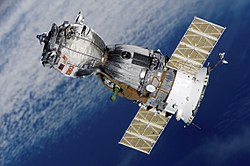| COSPAR ID | 1990-067A |
|---|---|
| SATCAT no. | 20722 |
| Mission duration | 130 days, 20 hours, 35 minutes, 51 seconds |
| Orbits completed | ~2,125 |
| Spacecraft properties | |
| Spacecraft type | Soyuz-TM |
| Manufacturer | NPO Energia |
| Launch mass | 7,150 kilograms (15,760 lb) |
| Crew | |
| Crew size | 2 up 3 down |
| Members | Gennady Manakov Gennady Strekalov |
| Landing | Toyohiro Akiyama |
| Callsign | Вулка́н (Vulkan – Volcano) |
| Start of mission | |
| Launch date | 1 August 1990, 09:32:21 UTC |
| Rocket | Soyuz-U2 |
| End of mission | |
| Landing date | 10 December 1990, 06:08:12 UTC |
| Landing site | 69 kilometres (43 mi) NW of Arkalyk |
| Orbital parameters | |
| Reference system | Geocentric |
| Regime | Low Earth |
| Perigee altitude | 198 kilometres (123 mi) |
| Apogee altitude | 219 kilometres (136 mi) |
| Inclination | 51.6 degrees |
| Period | 88.7 minutes |
| Docking with Mir | |
| Docking date | 3 August 1990, 11:45:44 UTC |
| Undocking date | 10 December 1990, 02:48:11 UTC |
 Soyuz programme (Crewed missions) | |
Soyuz TM-10 was the tenth expedition to the Russian Space Station Mir. [1]


